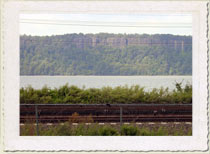
Riverdale Park
Raoul Wallenberg Forest Preserve
Borough: Bronx
Acres: 112
Habitat Type: Forest
Map: PDF
Riverdale Park Preserve is known for its secluded beauty, thick woods, spectacular views of the Palisades along the Hudson, and as a haven for birds. Twenty-seven species, including the screech owl (Otus asio), have been confirmed as breeding in the park. The bedrock of Riverdale is billion-year-old Fordham gneiss, the oldest rock formation in New York City. On top of the gneiss, lies Inwood marble, which was once quarried in Riverdale for the production of lime. Remains of two lime kilns stand in the park today.
Riverdale contains about 50 forested acres, including mature oak-hickory forest, a forest that occurs on well-drained sites, often on ridge tops, upper slopes, or south and west facing slopes. Composed mainly of five species of oak with black birch and hickory, the woods are on their way to becoming a mature or "climax" forest – a forest whose shade-tolerant seedlings will survive beneath their parents. Red oak is most common here, identifiable by its bristle-tipped leaves and vertically striped bark. Other oaks include black, chestnut, white, and the water-favoring pin oak growing further downslope.
Although probably every area of Riverdale Park has been cleared at one time or another, the southern part is covered by the same type of forest that existed in pre-colonial times, where tulip trees as tall as 110-feet rise from the slopes of the ravine. Red oaks, black birch, black cherry, and hickory are scattered throughout the canopy. At the end of the ravine, a small grove of witch hazel grows on the eroded bluffs overlooking the Hudson. In the spring, woodland wildflowers like jack-in-the-pulpit, bloodroot, and blue violet bloom along the shaded path. Later in summer, spikenard, blue-stemmed goldenrod, and joe-pye weed flower as well.
The Alderbrook wetland and surrounding forest have benefited from a Natural Resources Group restoration project, funded by the New York State Clean Water Clean Air Bond Act, Environmental Protection Fund, and the City. Prior to the restoration, the wetland was clogged by sediment from the Alderbrook stream and compacted soil around the railroad tracks. Stands of invasive mugwort and Japanese knotweed seven-feet high had crowded out other vegetation. The restoration re-created the stream channel and open water area, and replaced invasive forest vegetation with native. Breeding birds found in this area include yellow warblers and common yellowthroats, both of whom nest in the dense shrubbery.
Easy access to the Hudson River makes the path to the Alderbrook wetland one of the most heavily used trails in Riverdale Park. However, crossing the tracks is prohibited. High speed trains and 700 volts of electricity from Metro-North's third rail make crossing the tracks very dangerous.
The Raoul Wallenberg Forest is located across the street from Riverdale Park, and is named in honor of a Swedish diplomat who is credited with saving tens of thousands of Hungarian Jews from likely extermination by the Nazis during World War II. This site contains many trees with trunks more than 30 inches in diameter. These include two white oaks with trunks 45 inches in diameter, and a European beech with a trunk 52 inches in diameter. Raoul Wallenberg Forest is also home to several densely vegetated areas of blackberries, wineberries, grapes, roses, black locust, sumac trees, and various wildflowers. Dozens of species of birds, including downy woodpeckers, red-tailed hawks, and white-throated sparrows, are also indigenous to the park.
In 1999, the Urban Park Rangers' Parks Conservation Corps worked alongside a forestry crew to re-open the staircase that had been overgrown with vegetation for years. Erosion control, trail maintenance, and native species plantings were also included in this project to improve Raoul Wallenberg Forest, a living tribute to a man who gave his life for the safety and survival of tens of thousands of others.
Directions
By Rail: Metro-North Commuter Railroad from Grand Central Station to Riverdale. Park entrance on West 254th street just above train station.
By Subway: 1 train to 231st street. Board Bx10 or Bx7 at NW corner of Broadway and 231st. Leave bus at 252nd street, cross parkway bridge and walk west to Independence Avenue. Left on Independence to Spaulding Lane. Right down Spaulding to park entrance at parking lot.
Or A train to 207th street. Board Bx 7 or Bx 100 at corner of 211th-Isham Streets and Broadway. Exit bus at 252nd street. Follow walking directions above. Bus: M-100, Bx 10, or Bx 24 to 232nd street. Walk west on 232nd to park entrance.
Or take Bx 7 or Bx 10 to 252nd street and follow directions for above.
By Car: From east Take Major Deegan Northbound, exit at Henry Hudson Parkway southbound and take to 254th street exit. Follow 254th street west to parking area above train station. Or turn left at Independence Avenue and take right on Spaulding Lane to parking lot at bottom of hill.
From other points Exit Henry Hudson Parkway at West 232nd Street. Follow 232rd street west. Take right on Palisade Avenue to parking lot at Spaulding Lane. Or exit Henry Hudson Parkway at West 254th street and follow directions for above.
